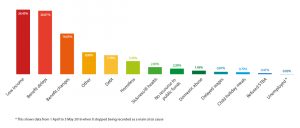Food bank use is on the rise
This post was written by our University of Notre Dame intern, Erin Sullivan. Erin is a Neuroscience and Behaviour major who spent the autumn volunteering with us as part of her London study abroad experience.
The Problem in the UK
Food bank use in the UK is on the rise according to a new report from the Trussell Trust.[i] The Trussell Trust, which has over 420 food banks across the UK, issues food vouchers for individuals in crisis who have been identified by care professionals such as doctors, health visitors, or social workers. These vouchers entitle the individual to a three-day emergency parcel of food. On average, a person who uses food banks receives two vouchers a year. According to the Trussell Trust, the charity provided 1,182,954 three-day emergency food supplies from April 2016-March 2017 compared to only 1,109,309 the year before, an increase of 73,634 parcels. The most common reasons for being referred to a Trussell Trust Food bank were low income (26.45%) and benefit delays (26.01%).

There is much anecdotal evidence about the link between low income and food bank use. Nurses, for example, have made headlines recently because in some cases their low wages are contributing to their need to resort to using food banks. According to the Royal College of Nursing, accounting for inflation, nurses wages have dropped 14% in the past 7 years.[i] This wage drop has been partially caused by recent pay freezes, or the 1% cap on wage increases that nurses and other public sector workers have endured since the market crash in 2008. The Royal College of Nursing has confirmed the reports of nurses resorting to food banks[ii] and nurses are just one example of underpaid employees turning to the Trussell Trust for food.
The Problem in America
America shows similar increasing trends of food bank use. Feeding America, a large food bank charity, reports serving an estimated 46.5 million people annually. 55% of individuals served report receiving Supplemental Nutrition Assistance Program (SNAP) benefits.[iii] SNAP benefits provide individuals in need with food stamps, with the benefit amount depending on their family size and income. In 2015, the average SNAP benefit was $125.57 per month.[iv] As evidenced by the high percentage of individuals receiving these benefits and also utilizing food banks, individuals are often supplementing the food from SNAP with food bank supplies. Additionally, some individuals may not qualify for federal assistance, such as SNAP, but still need help putting food on the table. According to Feeding America, 12% of households in America are estimated to be ‘food insecure’. Of those individuals who would be considered food insecure, 27% live in households that earn more than 185% above of the national poverty level, which means that they likely do not qualify for federal nutrition assistance programs, [v] yet still lack reliable access to sufficient food.
An analysis of client households conducted by Feeding America revealed that 20% of households reliant on food pantries or meal service programs offered by Feeding America had a family member in the military, either now or in the past. Furthermore, 43% of households receiving assistance reported having one member working full-time.[vi] Thus, the same pressures of low income present in the UK exist in America and contribute to the large population dependent on food banks.
Promoting Nutrition on a Budget
When people struggle to put food on the table, nutrition often becomes a secondary concern. Feeding America found that 79% of their clients reported purchasing unhealthy, inexpensive produce in order to simply ensure that they had enough food.[vii] This problem is compounded by limited access to healthy food options in low-income areas, and a need to increase knowledge of how to cook healthy, cheap meals. Here we examine a few organisations in the UK and the US that are working towards combatting food insecurity and giving people the tools (and food) they need to provide healthy meals for their family on a budget.
The Trussell Trust, the largest food bank provider in the UK, runs a course called ‘Eat Well Spend Less’ that aims to teach people budgeting and cooking skills. The course is free and runs for six sessions that covers the basics of budgeting, cooking, nutrition, and hygiene. The Trussell Trust has trained 61 food banks in its network to run the course. The course is intended to teach people basic cooking skills to enable them to cook healthy food; build an understanding of how to plan and budget for nutritious meals; and teach money management techniques.[viii]
One organisation that C3 worked with runs a programme that operates on a more personal level by working with families in their own homes to support increased physical activity and healthy cooking. This programme runs for 6 weeks, for 2 hours each week, and teaches cooking skills, and ways to get kids involved in more physical activities. The programme involves distributing the food parcels, then showing the recipients how to make the most out of those parcels with quick and easy cooking lessons. Tesco also has an agreement with the programme to provide herbs, spices, stock cubes and other goods that expand the meal options (and flavours) when cooking with food parcels. Among the many benefits of this programme, one is that by going into people’s homes, the very personal barriers that individuals and families face can be identified and alleviated. This might be as simple as providing a saucepan in the home.
Grow Ohio Valley is an organisation that operates out of Wheeling, West Virginia in the US and aims to address food insecurity in that region. Grow Ohio Valley has collaborated with West Virginia Northern Community College to create a food education programme called ‘Cooking in a SNAP’. The programme teaches participants three recipes a week, for 8 weeks, using a crockpot provided by Grow Ohio Valley that they can then take home. The crockpot is intended to facilitate cooking for working parents, as it cuts down on meal preparation time. During each class, participants are also provided with free, locally-grown produce courtesy of Grow Ohio Valley, that they can cook that meal with.[ix] Grow Ohio Valley has also instituted a programme called ‘SNAP Match’ in which people who receive SNAP benefits, or food stamps, can show their food stamp card and receive half-off the price of locally-grown produce.[x] Both of these programmes are working towards increasing the affordability and accessibility of healthy food for people who might not normally be able to afford it.
The evidence is clear that there is a pressing problem of food insecurity in both the UK and the US. Whether this is manifested in increasing emergency packs issued by food banks, or increasing numbers receiving government benefits, the results are the same. People are struggling to provide food for themselves, and their families. This poses a threat in terms of NCDs because in order to eat, people often must turn to unhealthy, cheap, convenience foods that are high in sugar and fat. This lack of proper nutrition poses a variety of health risks including cardiovascular disease, diabetes, and obesity. We have examined several organisations in both countries that are working towards breaking down the barriers people face to preparing healthy meals for their families. While the problem of food insecurity involves complex economic, political, and social factors, these organisations, along with countless others also often operating out of food banks, provide us with concrete examples of how we can work towards ensuring that everyone, regardless of income, can have enough nutritious food to eat.
References
[i] https://www.nursingtimes.net/news/show-me-the-money-if-nurses-use-food-banks-the-reasons-are-anything-but-complex/7017724.article
[ii] https://fullfact.org/economy/how-many-nurses-are-using-foodbanks/
[iii] http://www.feedingamerica.org/assets/pdfs/fact-sheets/poverty-and-hunger-fact-sheet.pdf
[iv] http://www.kff.org/other/state-indicator/avg-monthly-snap-benefits/?currentTimeframe=0&selectedRows=%7B%22wrapups%22:%7B%22united-states%22:%7B%7D%7D%7D&sortModel=%7B%22colId%22:%22Location%22,%22sort%22:%22asc%22%7D
[v] http://www.feedingamerica.org/assets/pdfs/fact-sheets/poverty-and-hunger-fact-sheet.pdf
[vi] http://help.feedingamerica.org/HungerInAmerica/hunger-in-america-2014-full-report.pdf?s_src=W179REFER&s_referrer=https%3A%2F%2Fwww.google.co.uk%2F&s_subsrc=http%3A%2F%2Fwww.feedingamerica.org%2F%3Freferrer%3Dhttps%3A%2F%2Fwww.google.co.uk%2F&_ga=2.47838948.251512748.1505913325-618904174.1505310152
[vii] http://help.feedingamerica.org/HungerInAmerica/hunger-in-america-2014-full-report.pdf?s_src=W179REFER&s_referrer=https%3A%2F%2Fwww.google.co.uk%2F&s_subsrc=http%3A%2F%2Fwww.feedingamerica.org%2F%3Freferrer%3Dhttps%3A%2F%2Fwww.google.co.uk%2F&_ga=2.47838948.251512748.1505913325-618904174.1505310152
[viii] https://www.trusselltrust.org/what-we-do/more-than-food/eat-well-spend-less/
[ix] http://www.theintelligencer.net/news/community/2016/09/cooking-on-a-budget-with-grow-ohio-valley-west-virginia-northern-community-college/
[x] http://www.theintelligencer.net/news/community/2016/09/prescribing-healthy-food-for-a-healthy-lifestyle/
[i] https://www.trusselltrust.org/wp-content/uploads/sites/2/2017/04/Early-Warnings-Universal-Credit-and-Foodbanks.pdf

